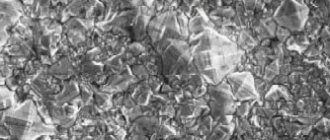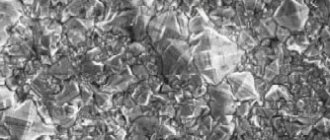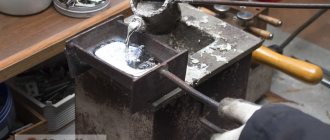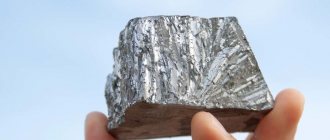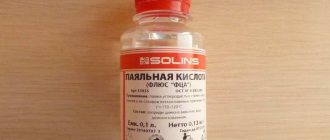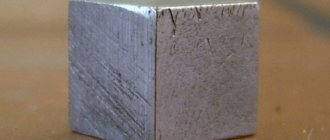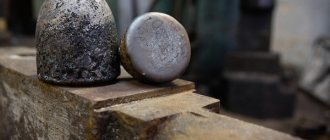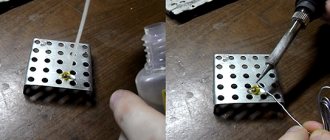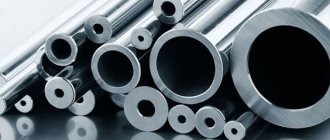There is a widespread belief that it is impossible to solder or tin aluminum (as well as alloys based on it) without special equipment for this.
Two factors are cited as an argument:
- upon contact with air, a chemically resistant and refractory oxide film (AL2O3) is formed on the surface of the aluminum part, resulting in an obstacle to the tinning process;
- The soldering process is significantly complicated by the fact that aluminum melts at a temperature of 660°C (for alloys this ranges from 500 to 640°C). In addition, the metal loses strength when, during the heating process, its temperature rises to 300°C (for alloys up to 250°C), which can cause a violation of the stability of aluminum structures.
Considering the above factors, it is truly impossible to solder aluminum using conventional means. The use of strong fluxes in combination with the use of special solders will help solve the problem. Let us consider these materials in detail.
Solder
Commonly used low-melting solder bases are tin (Sn), lead (Pb), cadmium (Cd), bismuth (Bi) and zinc (Zn). The problem is that aluminum is practically insoluble in these metals (with the exception of zinc), which makes the connection unreliable.
By using a flux with high activity and properly treating the joints, you can use tin-lead solder, but it is better to avoid such a solution. Moreover, a solder joint based on the Sn-Pb system has low corrosion resistance. Applying a paint coating to the soldering area allows you to get rid of this drawback.
For soldering aluminum parts, it is advisable to use solder based on silicon, copper, aluminum, silver or zinc. For example 34A, which consists of aluminum (66%), copper (28%) and silicon (6%), or the more common TsOP-40 (Sn - 60%, Zn - 40%).
Domestic solder – TsOP-40
Note that the higher the percentage of zinc in the solder, the stronger the connection and the higher its resistance to corrosion.
High-temperature solder is considered to be solder consisting of metals such as copper, silicon and aluminum. For example, like the above-mentioned domestic solder 34A, or its foreign analogue “Aluminium-13”, which contains 87% aluminum and 13% silicon, which allows soldering at temperatures from 590 to 600°C.
"Aluminum-13" produced by Chemet
When choosing a flux, it is necessary to take into account that not all of them can be active towards aluminum. We can recommend using products from a domestic manufacturer for such purposes - F-59A, F-61A, F-64, they consist of ammonium fluoroborates with the addition of triethanolamine. As a rule, the bottle is marked “for aluminum” or “for aluminum soldering.”
Domestic flux
For high-temperature soldering, you should purchase flux produced under the brand 34A. It consists of potassium chloride (50%), lithium chloride (32%), sodium fluoride (10%) and zinc chloride (8%). This composition is most optimal if high-temperature soldering is performed.
Recommended flux for packing at high temperatures
Application area of tinning
Shiny tin plating is used to ensure solderability, as a metal resist for printed circuit boards, or as a protective anti-corrosion and decorative coating for iron products. Most often, electrical parts (contacts, current-carrying busbars, grounding busbars, connectors), and products of the radio engineering and electrical industries are coated with tin. Coatings that consist of two or more metals are in particular demand among manufacturers of radio engineering products.
Tin plating is also used to protect against corrosion of an alloy exposed to organic acids contained in food products (tin cans).
Applying untarnished tin has several problematic issues:
- short shelf life for soldering, because over time (within several days) the solderability property decreases;
- After storage for a certain period of time, whiskers form on the surface, causing short circuits during operation of the equipment. Such burdens appear more often when tin is applied to copper, zinc, and brass products. The nickel sublayer somewhat slows down the thread growth process;
- to reduce the likelihood of thread formation, the tin coating should be melted, which leads to additional energy costs;
- at low temperatures, snow-white tin transforms into a shapeless state - grayish tin, with an increase in specific size and surface deformation (the so-called “tin plague”).
All these difficulties are simply eliminated by adding a small amount of bismuth (up to 5%). In addition, tin-bismuth coating is more resistant to corrosion than unsullied tin.
Bismuth is not used for contact with food products due to its toxicity!
Advantages of shiny tin plating:
- high-quality coating (free from damage and pores) perfectly protects steel from corrosion in atmospheric conditions;
- in almost all organic environments, tin plating is also a chemical protection against corrosion;
- shiny tin retains solderability characteristics for the longest time (more than one year) than matte coating;
- tolerates contact with plastics and rubber;
- the highest adhesion to the base metal and fairly high resistance to mechanical action (twisting, stretching, flaring, screwing, stamping).
Interesting read: How to clean darkened aluminum
Surface preparation
Before you begin tinning, you must complete the following steps:
- degrease the surface using acetone, gasoline or any other solvent;
- remove the oxide film from the place where soldering will be performed. For cleaning, use sandpaper, an abrasive wheel or a brush with steel wire bristles. As an alternative, etching can be used, but this procedure is not so common due to its specificity.
It should be taken into account that it will not be possible to completely remove the oxide film, since a new formation will immediately appear in the cleaned area. Therefore, stripping is carried out not with the goal of completely removing the film, but to reduce its thickness in order to simplify the task of the flux.
Heating the soldering area
To solder small parts, you can use a soldering iron with a power of at least 100W. Massive items will require a more powerful heating tool.
Soldering iron 300 Watt
The best option for heating is to use a gas burner or blowtorch.
Simple gas burner
When using a burner as a heating tool, the following nuances should be taken into account:
- Do not overheat the base metal, as it may melt. Therefore, it is necessary to regularly monitor the temperature during the process. This can be done by touching the solder to the heated element. Melting the solder will let you know that the required temperature has been reached;
- Oxygen should not be used to enrich the gas mixture, since it promotes strong oxidation of the metal surface.
What is necessary?
Working tools and material for the future design - this is what needs to be prepared before creating the device itself.
- Handle material. There are no strict criteria for its selection, so everything depends on the ingenuity and capabilities of the manufacturer. The handle should be comfortable and not warm up during operation. It is most reasonable to take a ready-made handle - a handle from a broken boiler or soldering station will do.
- Conducting tube. It must be steel, so the manufacturer chooses a steel tube with a diameter of no more than 1 cm and a wall thickness of 2.5 cm.
- Burner body. And it must be steel, and the divider is made of a brass rod.
- Nozzle. It is made from a metal rod.
Tools you will need: grinder, semi-automatic welding machine, file, drill press or drill, tap, drill bit, blade, hammer, pliers, stripping and cutting wheels, metal brush, protective equipment. You don't always need everything from the list, but it is included in the standard set.
Soldering instructions
The process of soldering aluminum parts does not have its own distinctive features; it is carried out in the same way as with steel or copper.
The algorithm of actions is as follows:
- the soldering area is degreased and cleaned;
- the parts are fixed in the desired position;
- the connection area heats up;
- touch the solder rod (containing active flux) to the joint. If flux-free solder is used, then flux is applied to destroy the oxide film, after which a solid piece of solder is rubbed over the soldering area.
Features and principles of soldering
The low temperature value of metal melting complicates the technological process of soldering, as well as repairing products with your own hands. Parts very quickly lose strength when heated, and structures reduce stability when the temperature reaches 300 degrees. Low-melting solders consisting of bismuth, cadmium, indium, and tin come into difficult contact with aluminum and do not provide sufficient strength. Excellent solubility is observed in the metal in combination with zinc, which makes the soldered areas highly reliable.
Before soldering begins, aluminum elements are well cleaned of oxides and dirt. To do this, you can use mechanical force with brushes or use special fluxes made from a potent composition. Before the procedure itself, be sure to tin the areas to be treated. The tin coating will protect the part from the formation of oxides. In order to reliably solder aluminum products, it is necessary to choose the right heating tool, taking into account the volume of metal being processed. In addition, the reliability of the connection depends on the alloy chosen, as well as the flux for soldering aluminum.
How to tin aluminum?
The highest quality aluminum welding is argon arc welding. However, this method requires both expensive equipment and highly qualified welders, which often does not always correspond to reality.
In addition, the equipment for this welding method is quite cumbersome and in some places its use is generally prohibited. In this article we will talk about alternative and inexpensive methods for welding aluminum without the use of argon.
Method 1: using Zeller 480 aluminum electrode
The Zeller 480 repair electrode with 12% silicon content is designed for welding a wide range of aluminum alloys including silumin and duralumin. This method allows you to reliably weld aluminum without the use of expensive argon arc equipment.
Benefits and Applications
- If the welding process is followed, the quality of the weld made using the Zeller 480 electrode is not inferior to argon arc welding;
- High surfacing productivity;
- Dense deposited metal without pores;
- Thanks to the soft, uniform arc, the seam is even and smooth;
- Zeller 480 is the only aluminum electrode available in a “low temperature” 2mm size;
- The electrode is equipped with a special protective coating, which is highly moisture resistant, which significantly extends the service life of the electrode;
- Welding is carried out without flux, since all the necessary elements for removing the oxide film are contained in the protective coating of the electrode;
- Used for welding aluminum sheets, profiles, busbars, tanks, aluminum castings, eliminating casting defects, crankcases, car bodies, etc.
Important! Since the coating of aluminum electrodes contains hygroscopic salts, after completing all welding work, the packaging should be hermetically sealed and stored in a dry, warm place.
Instructions for use
Step 1. Before starting welding, make sure that the prepared metal sample is dry, since aluminum is hygroscopic (absorbs moisture). Using a stainless brush, clean the joints to a metallic shine and remove any remaining dirt in the area around the seam.
Step 2. If necessary, dry the electrodes for 1-1.5 hours at 100°C.
Step 3. Heat the aluminum sample to a temperature of 150-200°C using a burner.
Important! Welding cannot be carried out without heating!
Step 4. Welding is carried out using direct current of reverse polarity. The most vertical position of the electrode while maintaining a short arc. The electrode should be fed into the fusion zone quickly, moving forward as much as possible and maintaining a very short arc.
Step 5: Weld one layer in one pass.
Be careful! The welding speed is the same as that of semi-automatic welding.
The tensile strength of the weld is 200 newtons per square millimeter, which is close to the tensile strength of the base metal. Therefore, this welding method can be used on critical structures.
Method 2: Using HTS-2000 or Castolin 192 solder
HTS-2000 or Castolin 192 solder is an alloy in the form of a zinc tube filled with solid flux powder in the center, which makes welding quick and easy.
The solder is made using high technology and is specially designed to carry out work on the restoration of parts made of aluminum.
At the same time, welding does not involve the use of high-cost technologies.
All you need to repair aluminum parts is just the solder itself and a gas torch for welding.
General recommendations for achieving the best results when working with solder
- Clean the work surface immediately before applying solder.
- You should not melt the solder in a torch flame, as this will prevent it from bonding to the metal.
The solder must melt on its own on the surface of the part! - In the liquid state, solder is quite fluid, so it is worth tinning the surface well to eliminate the presence of cracks, especially at the soldering site.
- Also make sure that the forming elements fit tightly together.
- When applying solder, wait until it absorbs.
Otherwise, sufficient adhesion of the metals will not occur, and, as a result, the required strength of the product will not be achieved.
How to solder aluminum with a soldering iron at home?
Aluminum is a metal that is difficult to solder. This is due to its tendency to form a strong oxide film on the surface of products, which prevents the part from being wetted by molten solder.
Mechanical cleaning of the surface alone does not help, since new oxide is formed instantly after removing the old one. For this reason, special fluxes are used for soldering aluminum and special technology is followed.
Connecting wires
Typically, aluminum soldering is used in cases where the parts to be joined are small enough and the use of argon welding is impossible or absent. One example of the use of soldering is connecting electrical wires made of different materials.
Often in practice it is necessary to connect copper and aluminum wires. Such connections cannot be made by twisting, since this pair of metals forms a source of electrochemical corrosion . In this case, soldering aluminum to copper can be an excellent connection option.
This operation can be performed with ordinary soft lead-tin solder, but you should use a special flux for soldering aluminum. The procedure must be performed in the following sequence:
- first you need to strip the copper wire and tin it using rosin;
- to tinning an aluminum wire, after mechanical stripping of the oxide film, it should be coated with a layer of flux for soldering aluminum;
- for better mechanical strength of the connection, tinned wires can be twisted;
- By heating the joint with a soldering iron and adding flux, the solder melts and a solder is formed.
The connection obtained in this way can be safely embedded in the wall; it will last for a very long time.
Removing the oxide film
Usually, if you have a good flux specifically designed for soldering aluminum, the use of any special tricks is not required; it is enough to mechanically clean it and moisten the surface to be soldered with flux.
It is also possible to use acid for soldering aluminum. They use hydrochloric acid in which zinc is dissolved (soldering acid), and fluxes based on orthophosphoric acid are also used.
But if such a flux is not available or, due to poor quality, does not provide soldering, you can go another way. There are several ways to remove the oxide film for successful tinning of the workpiece.
Soldering methods
Soldering of aluminum products is carried out with an electric soldering iron, a blowtorch or a gas torch. There are three ways to solder various aluminum objects:
- with rosin;
- using solders;
- electrochemical method.
With rosin
This option for soldering aluminum objects, wires, cables is used for small parts. To do this, the cleaned section of the electrical wire is covered with rosin and placed on a piece of sandpaper with a medium grain size. The wire is pressed from above with the tinned tip of a heated soldering iron. This action is carried out several times, after which the procedure of soldering the electrical wires itself is performed. You can use a rosin solution in diethyl ether.
In this case, the end of the soldering iron is not removed from the end being tinned, but rosin is added on top. An electric soldering iron with a power of about 50 W is suitable for twisting thin aluminum wires. With an aluminum thickness of about 1 mm, a 100 W soldering iron is required, and parts larger than 2 mm require preheating of the joint.
Using solders
This method is the most common and is used in electrical engineering, in the repair of automobile parts, as well as other products. Before soldering aluminum, the area to be soldered is pre-coated with an alloy and the tin-plated elements are subsequently connected. Pre-tinned parts are connected to each other, as well as to other alloys and metals.
Soldering of elements can be carried out using light alloy solders containing tin, zinc, and cadmium. In addition, refractory materials based on aluminum are actively used. Why are light alloy compounds used? Because they allow you to solder an aluminum product at temperatures up to 400 degrees. This does not produce qualitative changes in the properties of the metal and maintains its strength. Compositions with cadmium and tin do not create sufficient contact reliability and are susceptible to corrosive effects. Refractory materials containing zinc, copper, and aluminum-based silicon do not have these disadvantages.
How to solder aluminum with tin?
Soldering aluminum with standard solder using conventional technology is unreliable and impossible. The tin on it rolls into a ball, not wanting to stick, and if it does stick, the result is a weak connection that breaks under the slightest load. To prevent this from happening, you need to solder in a special way, and then even ordinary solder will hold tight.
Browse products for inventors. Link to the store.
- solder 60/40;
- mineral oil or petroleum jelly;
- alcohol.
How to solder aluminum correctly
An oxide film instantly forms on the surface of the aluminum, which prevents adhesion between the base and the solder. To prevent it from interfering, you need to create an airless environment at the soldering site. To do this, apply a thin layer of Vaseline to the area of aluminum that has been cleaned of dirt. You can use mineral or other automotive oil instead.
DIY electronics in a Chinese store.
If Vaseline was used, then you need to apply a soldering iron tip to it so that it melts into liquid oil. After this, take a mounting knife or other sharp object and use it to scratch the aluminum under the Vaseline.
It is important that the scratches are made on a surface that is sealed from air. As soon as the Vaseline begins to thicken, it should be melted again with a soldering iron tip.
You need to actively rub with a knife blade to remove the oxide film on the metal, and in addition to create a relief to which the solder will then stick well.
After removing the oxide film, the oil is not erased. A soldering iron tip is applied to the soldering site, and the aluminum is heated to operating temperature. Then the required amount of solder is deposited. It will sit right in the oil.
A drop of solder is lightly rubbed over the prepared surface. You need to press it into the resulting scratches. The solder will push the oil to the sides so it won't interfere with adhesion. The absence of an oxide film will allow the tin to stick to the aluminum, rather than forming into a ball that easily falls off.
Then, tinned wires, wire, or whatever is needed can be applied to the surface prepared with oil and friction. They will be soldered in a second, without taking all the tin from the aluminum, as usually happens. After soldering, the remaining oil is removed with a cotton swab soaked in alcohol.
This method allows you to achieve the same soldering reliability as when connecting two copper elements. Moreover, unlike another common method with oil, when the oxide film is removed by five minutes of friction with a hot soldering iron tip, tearing it off with a knife is faster.
How to solder aluminum correctly
Sometimes a situation arises when it is not possible to replace old aluminum wiring and you simply need to make a high-quality connection between aluminum and copper. For this, of course, you can use specialized connectors, crimps or terminal blocks, but I want to tell you how you can reliably and efficiently solder copper and aluminum.
What is the difficulty of soldering?
As you know, aluminum is a very active metal and when interacting with atmospheric air, it is almost instantly covered with an oxide film, which rejects the solder and does not allow aluminum to be simply tinned.
In order for the solder to “stick” well to the metal, you need to remove the existing film and prevent it from forming again until you apply the solder.
Special fluxes were invented specifically for these purposes: they actively use soldering acid, and use a mixture of rosin and acetone.
Preparing inventory
In order to successfully complete this work you will need: a soldering iron with a power of at least 60 W, a knife, pliers, sandpaper or a file, POS 61 or POS 50 solder, F-64 flux or its equivalent, a brush, a sponge and rags.
We solder aluminum with tin and F-64 flux
Important. Soldering of conductive elements using F-64 and any of its analogues is prohibited according to the rules of the PUE. Since the use of acid causes not only the destruction of the oxide film, but also actively destroys the metal itself, and after tinning, this acid cannot be removed and it continues destructive processes under the solder.
In this way you can, for example, solder an aluminum decorative part.
The algorithm for working with F-64 flux itself is very simple. First, we strip the insulation on the aluminum core, then use sandpaper or a knife to process the core itself in order to remove a thick layer of film.
Then we apply flux to the stripped core with a brush and clean it again under flux. Thus, the flux prevents the formation of a new film.
Then, using a well-heated soldering iron, we begin to apply tin to the prepared core. At the same time, you use a soldering iron to rub in solder.
Once you have tinned one track, apply flux again and repeat the procedure. This way you can completely cover the core with solder and then solder it to the place or part you need.
After you have completely processed the veins, you must rinse it in a soda solution (five tablespoons of soda per 200 grams of water). This is necessary to wash away the remaining active substances, which are part of F-64.
Soldering aluminum to copper using tin and rosin
In order to solder the conductive cores of copper and aluminum wires, you cannot use acid fluxes, but you need to use liquid rosin, which will also ensure a reliable connection.
This rosin can be purchased ready-made, or you can prepare it yourself; for this you will need lump rosin (it is crushed into powder) and pure alcohol.
Then we mix these two components in the following proportion: 60% rosin and 40% alcohol. Then put the bottle in warm water, wait until it warms up and mix thoroughly until the rosin is completely dissolved.
That's it, the solution is ready and you can use it.
Also, in addition to all the above equipment, we still need to prepare a small container into which we will immerse the stripped end of the wire.
We also remove the insulation and clean the core from a thick layer of foam, then immerse our bare end of the wire so that it is completely in liquid rosin and use a knife to process the core again.
Next, we take a preheated soldering iron and begin to process the core at the very surface of the rosin, rotating it and removing it as the wire is tinned.
The trick is to tin the aluminum right at the border between the rosin and the air so that the air does not oxidize it.
Make sure that the soldering iron does not lose temperature and, if necessary, remove it from the bath so that it warms up well.
Important. This work produces a lot of smoke, so it is better to do it outdoors or in a room with excellent forced ventilation.
After you have tinned the aluminum, the residual trace of rosin can be easily removed with a rag soaked in alcohol. You can then twist the tinned aluminum and copper wires into a classic twist and immediately solder it.
Tin will serve as an excellent neutralizer of the galvanic interaction of copper and tin and guarantees that such a connection will last a very long time and trouble-free.
Perhaps the only and significant drawback of such a connection of copper and aluminum is the fact that soldering in a distribution box located under the ceiling and in the absence of the proper supply is almost impossible.
In this case, it is better to use other methods of connecting the wires in the junction box.
That's all I wanted to tell you about soldering aluminum using special solders and regular tin with rosin. I hope you find this article useful and interesting. Thank you for your attention.
Source
Solders, materials, fluxes
Soldering of aluminum with tin is carried out subject to the use of highly active fluxes, as well as good cleaning of parts of the parts. Such tin compounds require additional coating with special compounds, since they have low strength and poor protection against corrosion processes.
How to solder aluminum elements? High-quality solder joints are obtained by using solders with silicon, aluminum, zinc, and copper. These materials are produced by both domestic and many foreign manufacturers. Domestic brands of rods are represented by the most used solders TsOP40, which according to GOST contain 60% tin and 40% zinc, as well as 34A (aluminum - 66%, silicon - 6%, copper - 28%). The zinc used gives high strength to the contact area and provides good corrosion resistance. Imported low-temperature alloys with excellent characteristics include HTS-2000, which provides maximum ease of use.
These alloys are used to work with large-sized parts (radiators, pipes) with high heat dissipation using a heating pad or objects made of aluminum alloys that have a fairly high melting temperature. Novice repairmen can familiarize themselves with the soldering process by watching an instructional video. This will help to avoid many unpleasant nuances during the work process.
In addition to solders, aluminum soldering requires the use of special fluxes containing ammonium fluoroborate, zinc fluoroborate, as well as triethanolamine and other elements. The most popular is the domestic F64, which has increased chemical activity. It can be used even without first removing the oxide film from products. In addition to it, 34A is used, containing lithium, potassium and zinc chlorides, as well as sodium fluoride.
Preservation techniques
Before you start working with a soldering iron, you always need to first study the safety rules.
- It is necessary to work only with the window open. Because you can get poisoned due to secretions during work.
- There shouldn't be anything flammable around. If a soldering iron is dropped onto paper, for example, this may cause a fire.
- The device should only be held by the special handle, as during operation it gets very hot, which can lead to burns.
- It is not allowed to let a child near the soldering iron. The device should be kept out of reach of the baby at all times.
- During breaks between soldering, the device can only be lowered onto a special stand. If the soldering iron is placed on the table, there may be a fire.
Follow these usual rules, and no problems will arise during work.
To create high-quality soldering of duralumin materials at home, you need to follow the technology one hundred percent. If you choose high-quality methods, solders, fluxes and materials, then the result will be positive.
Preparation of products
Reliability, as well as excellent quality of connections, is ensured not only by using the right technology, but also by preparatory work. These include the treatment of sealed surfaces. It is necessary to remove contaminants and thin oxide films.
Mechanical processing is carried out using sandpaper, a metal brush, stainless steel wire mesh or a grinding machine. In addition, various acid solutions are used for cleaning.
Surface degreasing is carried out using solvents, as well as gasoline or acetone. On the cleaned aluminum area, an oxide film appears almost immediately, but its thickness is significantly lower than the original one, which facilitates the soldering process.
Heating tools
How to solder aluminum at home? Electric soldering irons are used to solder small-sized aluminum products at home. They are a universal tool, quite convenient for soldering wires, repairing small tubes and other elements. They require a minimum of working space, as well as the presence of an electrical network. Repair of large-sized products and welding are performed with a gas torch that uses argon, butane, and propane. To solder aluminum objects at home, you can use a standard blowtorch.
When using gas burners, it is necessary to constantly monitor their flame, which characterizes a balanced supply of oxygen and gases. With the correct gas mixture, the fiery tongue has a bright blue color. A dim hue, as well as a small flame, indicate an excess of oxygen.
